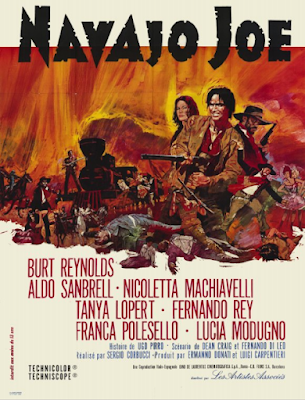Unfortunately for the actor, Navajo Joe (1966) was produced by legendary B-movie mogul Dino De Laurentiis in his first foray into the western genre. By the time Reynolds realised that the film was to be directed by Sergio Corbucci, not Leone as he had been led to believe, he could no longer back out of his contract. So Reynolds had to grit his teeth and bear his season of indentured servitude on location in Almería before fleeing back to the States.
Released to the withering reviews American critics enjoyed lavishing on Italian genre films in the sixties, Navajo Joe has never quite been rehabilitated in the way of Corbucci's other pictures. Reynolds regularly refers to the production as his worst experience in the business: true, no doubt, although the feelings of the star of such latter-day masterpieces as In the Name of the King: A Dungeon Siege Tale shouldn't be mistaken for critical judgment. Because Navajo Joe isn't just decent: it's a damn great spaghetti western, and far from Corbucci's least.
A band of peaceful Navajos (who live in tepees in the film's imagination) are massacred and scalped by bounty hunters led by Duncan (Aldo Sambrell). Pursued by a lone Indian warrior (Burt Reynolds), the killers make it to the nearest town, where they are informed that the state will no longer sanction their murder of Navajos. (This does not work out for the local sheriff, who is shot by Duncan in cold blood.) An alternative source of income opens up for the bandits, however, when Dr Chester Lynne (Pierre Cressoy) hires them to intercept a train carrying the sum of a million dollars to the small town of Esperanza.
The robbery goes to plan at first, but the Navajo warrior manages to steal the train Duncan's men have secured from under their noses and take it to Esperanza, whose citizens he offers his help in fending off Duncan. The townsfolk, however, prefer to trust in sending the secretly treacherous Dr Lynne for help. Joe sticks around, meanwhile, for revenge and to help Estella (Nicoletta Machiavelli), Mrs Lynne's half-indigenous servant.

Pace some critics, the plot seems rather good to me: straightforward but with clear stakes, and kicked off with the effective trope of a man seeking revenge for the murder of his family. The problem, really, is the characters. Machiavelli's Estella is awfully underdeveloped, and her importance to the plot seems to fluctuate wildly from scene to scene. Worse, Sambrell's Duncan has little in the way of clear motivation. He hates both Indians and white people because as a 'half-breed' he was ostracised by both - well and good; but that motive only appears here and there, and for much of the film he behaves villainously because it's expected of him. We don't come to spaghetti westerns for characters with a compelling inner life, but a little more wouldn't hurt.
That would matter less if Reynolds's performance was better. A gruelling shoot can translate into compelling cinema - see Apocalypse Now, or every Werner Herzog/Klaus Kinski collaboration - but here Reynolds's misery just shows in every scene. And the wisdom of casting him as a Native American could certainly be questioned, part-Cherokee or no: at a time when blackface had thankfully been consigned to the past, a white person with copious fake tan and an awkward wig was still thought a good enough approximation of a Native American. (Case in point: the even more Aryan Machiavelli.) Of course, given structural racism in the industry there weren't exactly many high-profile indigenous actors, but someone had to break that vicious cycle.


At the level of script and acting, then, Navajo Joe is certainly not above reproach. But hell, Corbucci's direction is another thing entirely. Full of terrific compositions and stark angles, Navajo Joe is even more aggressively stylised than Django, achieving a rough-hewn poetry that was not surpassed until Leone's Once Upon A Time in the West two years later (and which, arguably, Corbucci himself never achieved again). Occasionally the flourishes threaten to tip the film into ridiculousness, but all in all Corbucci manages the balance.
Even inventive direction can't stop the film from sagging a little in its third act, but for most of its running time Navajo Joe is basically perfect by spaghetti western criteria: amazing visuals, taciturn badasses, and nihilistic violence. Oh, right: this film is brutal by the standards of the sixties. Corbucci just about has the decorum to turn away during the scalpings, but the gruesome trophies themselves are waved about gleefully, and bleached skulls make frequent appearances. It may be a coincidence that Ruggero Deodato, whose infamous Cannibal Holocaust (1980) reduced the human body to bloody pieces, worked as Corbucci's assistant director on this film; but it certainly feels as if there should be a connection.


No comments:
Post a Comment